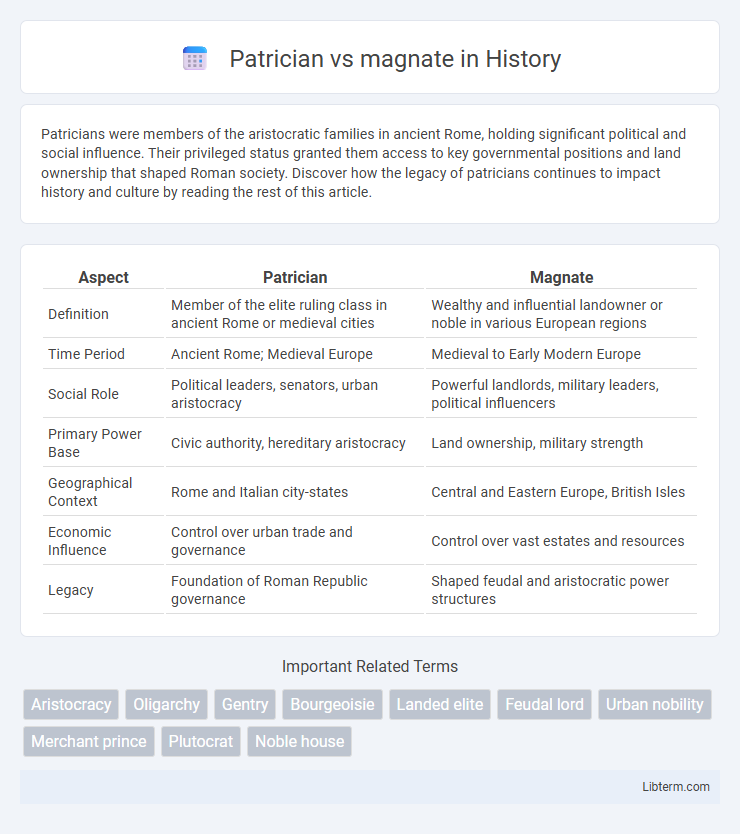Patricians were members of the aristocratic families in ancient Rome, holding significant political and social influence. Their privileged status granted them access to key governmental positions and land ownership that shaped Roman society. Discover how the legacy of patricians continues to impact history and culture by reading the rest of this article.
Table of Comparison
| Aspect | Patrician | Magnate |
|---|---|---|
| Definition | Member of the elite ruling class in ancient Rome or medieval cities | Wealthy and influential landowner or noble in various European regions |
| Time Period | Ancient Rome; Medieval Europe | Medieval to Early Modern Europe |
| Social Role | Political leaders, senators, urban aristocracy | Powerful landlords, military leaders, political influencers |
| Primary Power Base | Civic authority, hereditary aristocracy | Land ownership, military strength |
| Geographical Context | Rome and Italian city-states | Central and Eastern Europe, British Isles |
| Economic Influence | Control over urban trade and governance | Control over vast estates and resources |
| Legacy | Foundation of Roman Republic governance | Shaped feudal and aristocratic power structures |
Introduction to Patricians and Magnates
Patricians were elite members of ancient Roman aristocracy, holding political power, land, and social status, while magnates were influential landowners or businessmen in later European societies known for their wealth and economic dominance. Both groups shaped governance and society through their control of resources and social networks. Understanding the distinctions highlights the evolution of elite power from hereditary nobility to wealth-based influence.
Historical Origins of Patricians
Patricians originated in ancient Rome as members of the original aristocratic families who held exclusive political and religious rights, distinguishing them from the plebeians, the common populace. Their status was hereditary, rooted in the early Roman Kingdom and Republic, where land ownership and lineage secured social privileges and influence within the Senate and priesthood. In contrast, magnates emerged primarily during the medieval and Renaissance periods as powerful landowners or businessmen whose wealth and influence were not always linked to noble birth but often acquired through commerce or royal favor.
The Rise of Magnates in Society
The rise of magnates in society marked a shift from the hereditary privileges of patricians to the wealth-based influence of new elites. Magnates accumulated power through commerce, landownership, and strategic alliances, often surpassing the traditional authority held by patricians. This transformation redefined social hierarchies, emphasizing economic capital over noble lineage as the primary source of social dominance.
Social Status and Class Distinctions
Patricians were members of the elite hereditary aristocracy in ancient Rome, holding exclusive political power and social prestige, while magnates were wealthy landowners or influential individuals often rising through economic success rather than birthright. Patricians represented the ruling class with privileges tied to noble lineage, whereas magnates occupied a high status in society primarily due to their vast wealth and patronage networks, sometimes challenging patrician dominance. Social class distinctions between the two revolved around inherited nobility for patricians versus acquired influence and wealth for magnates, reflecting the evolving power dynamics within elite circles.
Economic Roles: Wealth and Influence
Patricians held wealth primarily through inherited land and political power within ancient Roman society, establishing economic influence via landownership and governance roles. Magnates, often emerging in later historical contexts, accumulated wealth through commerce, industry, and banking, leveraging economic enterprises to exert social and political influence. Both classes shaped economic landscapes by dominating resource control, but patricians emphasized aristocratic nobility while magnates focused on mercantile and industrial capital accumulation.
Political Power and Governance
Patricians held hereditary political power in ancient Roman society, dominating the Senate and key governance institutions to shape laws and policies. Magnates, often wealthy landowners or influential merchants in later periods, exerted localized power through patronage networks and economic influence rather than formal political office. The distinction lies in patricians' institutional authority versus magnates' reliance on social and economic capital to impact governance and political decisions.
Cultural Impact and Legacy
Patricians shaped urban culture and political institutions in ancient Rome, influencing art, architecture, and governance models that persist in Western history. Magnates dominated economic and social spheres in medieval and early modern Europe, driving the development of trade networks, patronage of the arts, and the rise of state power. Both classes left enduring legacies by fostering cultural patronage and political frameworks that shaped the identities of their respective societies.
Patrician vs Magnate: Key Differences
Patricians were members of the elite hereditary aristocracy in ancient Rome, holding political power and social prestige through lineage and tradition. Magnates, in contrast, were wealthy and influential individuals, often from various periods and regions, who gained prominence primarily through economic power, commerce, or land ownership rather than hereditary status. The key difference lies in patricians' inherited noble status versus magnates' acquired influence based on wealth and personal achievements.
Modern Perspectives on Elites
Modern perspectives on elites distinguish patricians as members of hereditary aristocracy with long-standing social status, while magnates are recognized for their influence derived from substantial economic power and business acumen. Contemporary sociological analyses emphasize magnates' role in shaping global markets and political policies through wealth accumulation, contrasting with patricians' symbolic capital rooted in lineage and tradition. This differentiation highlights changing dynamics in elite power structures, where economic dominance increasingly redefines elite legitimacy in capitalist societies.
Conclusion: Relevance Today
Patricians remain symbolic of ancient aristocratic heritage, reflecting lineage-based influence in modern sociocultural contexts, while magnates exemplify contemporary economic power through commercial and industrial dominance. The relevance today lies in how magnates shape global markets and innovation, whereas patricians often serve as cultural and historical references rather than direct power holders. Understanding this distinction highlights the evolution from inherited status to meritocratic and capital-driven influence in current societies.
Patrician Infographic

 libterm.com
libterm.com